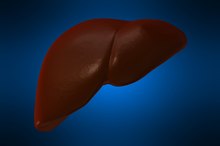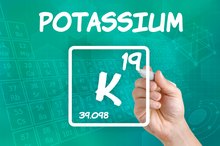What does fact checked mean?
At Healthfully, we strive to deliver objective content that is accurate and up-to-date. Our team periodically reviews articles in order to ensure content quality. The sources cited below consist of evidence from peer-reviewed journals, prominent medical organizations, academic associations, and government data.
The information contained on this site is for informational purposes only, and should not be used as a substitute for the advice of a professional health care provider. Please check with the appropriate physician regarding health questions and concerns. Although we strive to deliver accurate and up-to-date information, no guarantee to that effect is made.
What Does a High Potassium Blood Level Mean?
Potassium is essential to many vital processes in the body. Potassium is involved in the proper functioning of nerve and muscle cells, digestion, metabolism and maintaining the balance of both electrical and chemical processes in the body. Potassium is especially important in cardiac function. Normal serum potassium levels range between 3.6 and 4.8 mEq/L. A high level of potassium in the blood is often indicative of an underlying kidney dysfunction.
Causes
High blood potassium, or hyperkalemia, often indicates that the body is producing too much potassium or that the kidneys can no longer remove excess potassium properly. Hyperkalemia can indicate kidney failure, infection, obstruction or even a transplant rejection. The hormone aldosterone regulates how the kidneys remove excess sodium and potassium. A lack of aldosterone can lead to an elevation of blood potassium, according to the National Institutes of Health 1. Anytime potassium releases from the cells it can raise potassium levels. A condition known as acidosis will move potassium from inside the cells to the fluid outside. Tissue injuries such as burns, traumatic injury, hemolytic conditions in which blood cells burst and muscle breakdown can all lead to acidosis and increased serum potassium.
- High blood potassium, or hyperkalemia, often indicates that the body is producing too much potassium or that the kidneys can no longer remove excess potassium properly.
- Tissue injuries such as burns, traumatic injury, hemolytic conditions in which blood cells burst and muscle breakdown can all lead to acidosis and increased serum potassium.
Symptoms
Symptoms of Potassium Overdose
Learn More
A slight elevation in serum potassium will often not cause symptoms. However, when potassium increases, it causes disturbances in electrical functions of the body, interfering with the heart's ability to beat properly. The University of Maryland Medical Center explains that as potassium increases, people are likely to notice muscle aches and cramps, fatigue, weakness, difficulty breathing, irregular heartbeat, nausea, and weak or absent pulses. Elevated serum potassium can lead to life-threatening complications including paralysis, cardiac arrest and death.
- A slight elevation in serum potassium will often not cause symptoms.
- Elevated serum potassium can lead to life-threatening complications including paralysis, cardiac arrest and death.
Testing
Testing for an elevated serum potassium level involves a simple blood test performed in a lab, physician’s office or hospital 2. Commonly, the medical staff will run a panel of all electrolytes as well as test kidney and liver function. Elevated serum potassium does not necessarily mean that the kidneys are malfunctioning or that there is an underlying disease process at work. In some cases, an elevated blood potassium level can appear falsely elevated. Physicians will often retest if an error is suspected.
- Testing for an elevated serum potassium level involves a simple blood test performed in a lab, physician’s office or hospital 2.
Considerations
Normal Sodium & Potassium Blood Levels
Learn More
There are many reasons why a person’s potassium may appear elevated. Lab Tests Online explains that clenching and relaxing the fist repeatedly during collection of the sample can cause a false elevation 2. Improper testing of the blood by the lab can also lead to a false elevation, as can allowing the sample to sit at room temperature for too long prior to testing. Crying or rapid, shallow breathing can also lead to a false elevation.
- There are many reasons why a person’s potassium may appear elevated.
- Improper testing of the blood by the lab can also lead to a false elevation, as can allowing the sample to sit at room temperature for too long prior to testing.
Treatments
If physicians confirm a diagnosis of hyperkalemia, treatment will involve not only treating the underlying condition but also balancing potassium levels. Calcium chloride or gluconate will help to minimize the effects of the excess potassium on the heart. Insulin, sodium bicarbonate and beta agonists will all help to promote the shift of potassium from blood to cells, according to the University of Maryland Medical Center. Diuretics can help promote excretion of excess calcium from the kidneys.
- If physicians confirm a diagnosis of hyperkalemia, treatment will involve not only treating the underlying condition but also balancing potassium levels.
- Calcium chloride or gluconate will help to minimize the effects of the excess potassium on the heart.
Related Articles
References
- National Institutes of Health: Hyperkalemia
- Lab Tests Online: Potassium
- Dylewski JF, Linas S. Variability of potassium blood testing: Imprecise nature of blood testing or normal physiologic changes? Mayo Clinic Proceedings. 2018. 93(5):551-554. doi:10.1016/j.mayocp.2018.03.019
- Friedman PA, Scott CG, Bailey K, et al. Errors of classification with potassium blood testing: The variability and repeatability of critical clinical tests. Mayo Clinic Proceedings. 2018;93(5):566-572. doi:10.1016/j.mayocp.2018.03.013
- Galloway CD, Valys AV, Shreibati JB, et al. Development and validation of a deep-learning model to screen for hyperkalemia from the electrocardiogram. JAMA Cardiology. 2019. 4(5):428-436. doi: 10.1001/jamacardio.2019.0640
- National Heart, Lung, and Blood Institute. Blood tests.
- Ialongo C, Bernardini S. Phlebotomy, a bridge between laboratory and patient. Biochem Med (Zagreb). 2016;26(1):17–33. doi:10.11613/BM.2016.002
- Schmidt ST, Ditting T, Deutsch B, et al. Circadian rhythm and day to day variability of serum potassium concentration: A pilot study. Journal of Nephrology. 2015. 28(2):165-72. doi:10.1007/s40620-014-0115-7
- Chatterjee R, Yeh HC, Shafi T, et al. Serum potassium and the racial disparity in diabetes risk: the Atherosclerosis Risk in Communities (ARIC) Study. American Journal of Clinical Nutrition. 2011. 93(5):1087-91. doi:10.3945/ajcn.110.007286
- Cleveland Clinic. Hyperkalemia (high blood potassium). Updated October 19, 2016.
- Cleveland Clinic. Low potassium levels in your blood (hypokalemia). Updated March 12, 2018.
- Kardalas E, Paschou SA, Anagostis P, et al. Hypokalemia: a clinical update. Endocrine Connections. 2018;7(4):R135-R146. doi:10.1530/EC-18-0109
- Cleveland Clinic. Low potassium levels in your blood (hypokalemia): Management and treatment. Updated March 12, 2018.
- Bnaya A, Ruchlemer R, Itzkowitz E, Gabbay E, Shavit L. Pseudohyperkalemia in chronic lymphocytic leukemia. American Journal of Medicine. 2020;133(2):e52-e53. doi:10.1016/j.amjmed.2019.07.037
- Ben Salem C, Badreddine A, Fathallah N, Slim R, Hmouda H. Drug-induced hyperkalemia. Drug Safety. 2014. 37(9):677-92. doi:10.1007/s40264-014-0196-1
- Cleveland Clinic. How can hyperkalemia (high blood potassium levels) be treated? Updated October 19, 2016.
- Miller KC. Plasma potassium concentration and content changes after banana ingestion in exercised men. J Athl Train. 2012;47(6):648–654. doi:10.4085/1062-6050-47.6.05
- American Association for Clinical Chemistry. Potassium. Updated 12/13/19.
- Jameson JL, et. al. Harrison's Principles of Internal Medicine, 20th Edition. McGraw Hill Education. 2018.
- Kovesdy CP, Appel LJ, Grams ME, et al. Potassium homeostasis in health and disease: A scientific workshop cosponsored by the National Kidney Foundation and the American Society of Hypertension. Journal of the American Society of Hypertension. 2017;11(12):783-800. doi:10.1016/j.jash.2017.09.011
- Nilsson E, Gasparini A, Arnlov J, et al. Incidence and determinants of hyperkalemia and hypokalemia in a large healthcare system. International Journal of Cardiology. 2017;15;245:277-284. doi:10.1016/j.ijcard.2017.07.035
- Pagana KD, Pagana TJ, Pagana TN. Mosby’s Diagnostic & Laboratory Test Reference. 14th ed. St. Louis, Mo: Elsevier; 2019.
- Schrier RW. Renal and Electrolyte Disorders, 8th Edition. LWW. 2017.
- Shrimanker I, Bhattarai S. Electrolytes. in: StatPearls. Updated January 20, 2020.
Writer Bio
Based in Florida, Martina McAtee has been writing health and fitness articles since 2003. She attended Keiser University, graduating with an Associate of Science in nursing. McAtee is currently working toward a master's degree in nursing from Florida Atlantic University.









